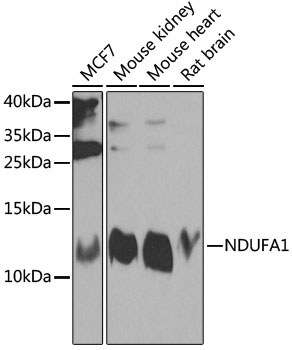Cell Biology Antibodies 12
Anti-NDUFA1 Antibody (CAB8326)
- SKU:
- CAB8326
- Product Type:
- Antibody
- Applications:
- WB
- Reactivity:
- Human
- Reactivity:
- Mouse
- Reactivity:
- Rat
- Host Species:
- Rabbit
- Isotype:
- IgG
- Research Area:
- Cell Biology
Description
| Antibody Name: | Anti-NDUFA1 Antibody |
| Antibody SKU: | CAB8326 |
| Antibody Size: | 20uL, 50uL, 100uL |
| Application: | WB |
| Reactivity: | Human, Mouse, Rat |
| Host Species: | Rabbit |
| Immunogen: | Recombinant fusion protein containing a sequence corresponding to amino acids 1-70 of human NDUFA1 (NP_004532.1). |
| Application: | WB |
| Recommended Dilution: | WB 1:500 - 1:2000 |
| Reactivity: | Human, Mouse, Rat |
| Positive Samples: | MCF-7, Mouse kidney, Mouse heart, Rat brain |
| Immunogen: | Recombinant fusion protein containing a sequence corresponding to amino acids 1-70 of human NDUFA1 (NP_004532.1). |
| Purification Method: | Affinity purification |
| Storage Buffer: | Store at -20'C. Avoid freeze / thaw cycles. Buffer: PBS with 0.02% sodium azide, 50% glycerol, pH7.3. |
| Isotype: | IgG |
| Sequence: | MWFE ILPG LSVM GVCL LIPG LATA YIHR FTNG GKEK RVAH FGYH WSLM ERDR RISG VDRY YVSK GLEN ID |
| Gene ID: | 4694 |
| Uniprot: | O15239 |
| Cellular Location: | Matrix side, Mitochondrion inner membrane, Single-pass membrane protein |
| Calculated MW: | 8kDa |
| Observed MW: | 14kDa |
| Synonyms: | NDUFA1, CI-MWFE, MWFE, ZNF183 |
| Background: | The human NDUFA1 gene codes for an essential component of complex I of the respiratory chain, which transfers electrons from NADH to ubiquinone. It has been noted that the N-terminal hydrophobic domain has the potential to be folded into an alpha-helix spanning the inner mitochondrial membrane with a C-terminal hydrophilic domain interacting with globular subunits of complex I. The highly conserved two-domain structure suggests that this feature is critical for the protein function and might act as an anchor for the NADH:ubiquinone oxidoreductase complex at the inner mitochondrial membrane. However, the NDUFA1 peptide is one of about 31 components of the 'hydrophobic protein' (HP) fraction of complex I which is involved in proton translocation. Thus the NDUFA1 peptide may also participate in that function. |
| UniProt Protein Function: | NDUFA1: Accessory subunit of the mitochondrial membrane respiratory chain NADH dehydrogenase (Complex I), that is believed not to be involved in catalysis. Complex I functions in the transfer of electrons from NADH to the respiratory chain. The immediate electron acceptor for the enzyme is believed to be ubiquinone. Defects in NDUFA1 are a cause of mitochondrial complex I deficiency (MT-C1D). A disorder of the mitochondrial respiratory chain that causes a wide range of clinical disorders, from lethal neonatal disease to adult-onset neurodegenerative disorders. Phenotypes include macrocephaly with progressive leukodystrophy, non-specific encephalopathy, cardiomyopathy, myopathy, liver disease, Leigh syndrome, Leber hereditary optic neuropathy, and some forms of Parkinson disease. Belongs to the complex I NDUFA1 subunit family. |
| UniProt Protein Details: | Protein type:Oxidoreductase; Mitochondrial; EC 1.6.5.3; Membrane protein, integral; Energy Metabolism - oxidative phosphorylation; EC 1.6.99.3 Chromosomal Location of Human Ortholog: Xq24 Cellular Component: mitochondrion; mitochondrial inner membrane; mitochondrial membrane; integral to membrane; mitochondrial respiratory chain complex I Molecular Function:NADH dehydrogenase (ubiquinone) activity Biological Process: cellular metabolic process; mitochondrial electron transport, NADH to ubiquinone Disease: Mitochondrial Complex I Deficiency |
| NCBI Summary: | The human NDUFA1 gene codes for an essential component of complex I of the respiratory chain, which transfers electrons from NADH to ubiquinone. It has been noted that the N-terminal hydrophobic domain has the potential to be folded into an alpha-helix spanning the inner mitochondrial membrane with a C-terminal hydrophilic domain interacting with globular subunits of complex I. The highly conserved two-domain structure suggests that this feature is critical for the protein function and might act as an anchor for the NADH:ubiquinone oxidoreductase complex at the inner mitochondrial membrane. However, the NDUFA1 peptide is one of about 31 components of the "hydrophobic protein" (HP) fraction of complex I which is involved in proton translocation. Thus the NDUFA1 peptide may also participate in that function. [provided by RefSeq, Jul 2008] |
| UniProt Code: | O15239 |
| NCBI GenInfo Identifier: | 3334271 |
| NCBI Gene ID: | 4694 |
| NCBI Accession: | O15239.1 |
| UniProt Related Accession: | O15239 |
| Molecular Weight: | 8,072 Da |
| NCBI Full Name: | NADH dehydrogenase |
| NCBI Synonym Full Names: | NADH dehydrogenase (ubiquinone) 1 alpha subcomplex, 1, 7.5kDa |
| NCBI Official Symbol: | NDUFA1 |
| NCBI Official Synonym Symbols: | MWFE; ZNF183; CI-MWFE |
| NCBI Protein Information: | NADH dehydrogenase [ubiquinone] 1 alpha subcomplex subunit 1; NADH dehydrogenase [ubiquinone] 1 alpha subcomplex subunit 1; complex I-MWFE; type I dehydrogenase; complex I MWFE subunit; NADH oxidoreductase subunit MWFE; NADH:ubiquinone oxidoreductase (com |
| UniProt Protein Name: | NADH dehydrogenase [ubiquinone] 1 alpha subcomplex subunit 1 |
| UniProt Synonym Protein Names: | Complex I-MWFE; CI-MWFE; NADH-ubiquinone oxidoreductase MWFE subunit |
| UniProt Gene Name: | NDUFA1 |
| UniProt Entry Name: | NDUA1_HUMAN |
View AllClose







